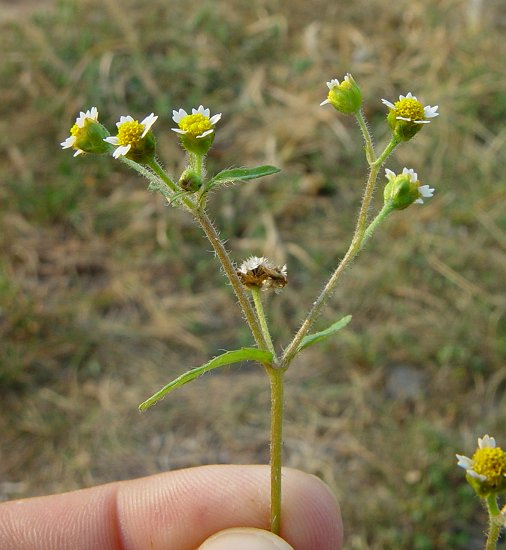Galinsoga quadriradiata Ruiz & Pav.
Fringed Quickweed

Introduced
CC = *
CW = 3
MOC = 16
© DETenaglia
Galinsoga quadriradiata Ruiz & Pav.Fringed Quickweed | |
 |
Introduced CC = * CW = 3 MOC = 16 |
© DETenaglia |
|
Family - Asteraceae/Heliantheae Habit - Taprooted annual forb. Stem - Ascending to erect, to 70 cm, usually branched, moderately to densely pubescent with spreading hairs, those toward the stem tips with minute, dark, glandular tips.
Leaves - Opposite, simple, petiolate. Blades lanceolate to broadly ovate, 2-7 cm long, unlobed, mostly angled to short-tapered at the base, angled or tapered to a sharply pointed tip, the margins entire or more commonly sparsely to moderately toothed and with short, slender, spreading hairs, the surfaces sparsely to densely pubescent with short, slender, spreading hairs, usually with 3 main veins.
Inflorescences - Open, irregular panicles of heads, or occasionally solitary heads, with small, leaflike bracts at the branch points, the heads appearing mostly long-stalked. Heads - Radiate. Involucre 3-5 mm long, 3-6 mm in diameter, cup-shaped, usually sparsely pubescent with spreading, gland-tipped hairs, with an outer series of 2 or 3 bracts and an inner series of 4-6 bracts, these fused basally with 2 or 3 adjacent chaffy bracts and this group shed as an intact unit with the fruits developing from the ray florets. Chaffy bracts subtending the disc florets mostly unlobed or shallowly 2- or 3-lobed for less than 1/5 of their length, shed with the fruits.
Florets - Ray florets with a well-developed pappus about as long as the corolla tube. Disc florets with the pappus scales tapered to a sharply pointed, often minutely awned tip.
Fruits - Achenes 1.5-2.5 mm long, narrowly wedge-shaped to wedge-shaped in outline, 4-angled, those of the ray florets usually slightly flattened, the surface usually with minute, yellowish, ascending hairs, black, those of the disc florets shed individually with their subtending chaffy bract, those of the ray florets either shed separately or as an intact unit with the basally fused adjacent 2 or 3 chaffy bracts and the adjacent inner involucral bract.
Flowering - May - November. Habitat - Streambanks, gardens, farmyards, railroads, roadsides, open disturbed areas. Origin - Native to Central and South America. Lookalikes - G. parviflora. Other info. - This little species can be found in a few widely scattered locations throughout Missouri, the upper Midwest, and New England. The plant can be identified by its small flowering heads, opposite leaves, and hairy stems. The small ray ligules with three blunt teeth at the tips are distinctive. It commonly shows up in flower beds and in cultivated fields. Photographs taken in Marquette, MI., 9-10-2003 (DETenaglia); also in St. Louis, 7-23-2015, and near Fremont, Newaygo County, MI, 7-20-2022 (SRTurner) |